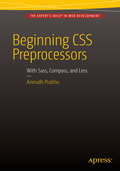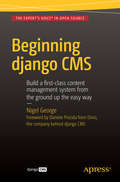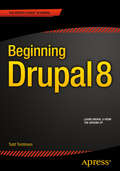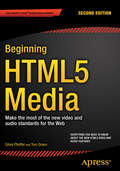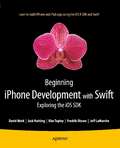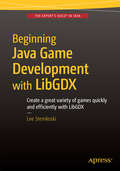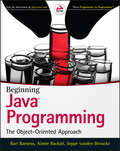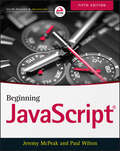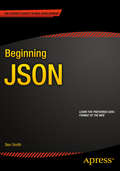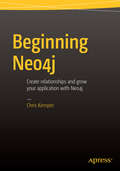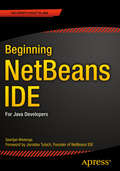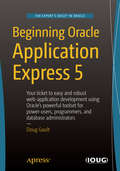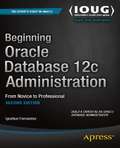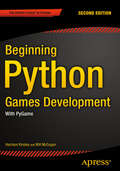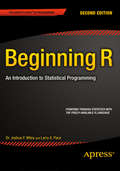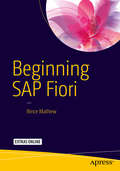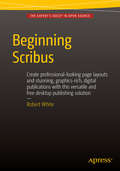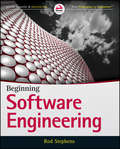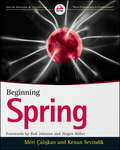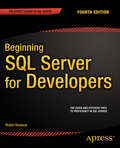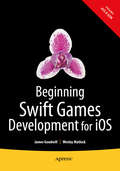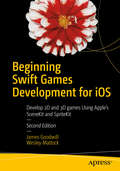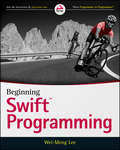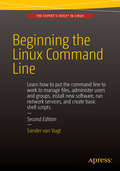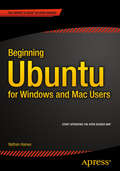- Table View
- List View
Beginning CSS Preprocessors: With SASS, Compass.js and Less.js
by Anirudh PrabhuLearn how preprocessors can make CSS scalable and easy to maintain. You'll see how to write code in a very clean and scalable manner and use CSS preprocessor features such as variables and looping, which are missing in CSS natively. Reading Beginning CSS Preprocessors will make your life much simpler by showing you how to create reusable chunks of code. In addition to coding enhancements, you'll also learn to automate processes such as generating image sprites and minifying code. Beginning CSS Preprocessors is your guide for getting started with CSS preprocessors. This book shows you how to use CSS in your day-to-day work and thus be smart and efficient at writing CSS. What you'll learn What are preprocessors What are the known preprocessor frameworks What are the features of Sass (Syntactically Awesome Stylesheets) What is Compass (COMPrehensive ASSembler) What is Less (Leaner SS) Who this book is for UI developers who are well acquainted with CSS and want to make their workflow better. Table of Contents Chapter 1: Introduction to Preprocessors Chapter 2: Introduction to SASS Chapter 3: Advanced SASS Chapter 4: Development with Less Chapter 5: Introduction to Compass
Beginning django CMS
by Nigel GeorgeBuild a world-class website in less than a week with Django CMS. Beginning Django CMS shows you how to simply and easily write a dynamic website with a full content management system in the backend. It is written for Internet developers who are sick and tired of dealing with complicated, bloated website frameworks that are a pain to build and a nightmare to maintain. Django CMS is an Open Source website building framework that is experiencing exponential growth because it is built on the simple, secure and scalable architecture of Django. This book takes you from knowing nothing about Django CMS, to building a functional website and content management system that you can deploy for your own website or for your customers. What you'll learn How to build a dynamic website quickly and easily How to author and submit content for publication How to administer Django CMS How to install and use custom and third-party plugins How to deploy a website using Django CMS Who this book is for Programmers, in particular Python and Django programmers, wishing to build a simple, custom content management system (CMS). They do not have to be directly interested in the Django CMS application, Beginning Django CMS will be equally useful to a programmer looking to build a functioning CMS rapidly. Table of Contents 1. Working With a CMS 2. Installing Django CMS 3. Introduction to Django CMS 4. Site Templates 5. Your Blog Website: Templates 6. Django CMS: Plugins 7. Advances Plugins 8. Authoring in Django CMS 9. Menus and Navigation 10. Extending Django CMS 11. Next Steps
Beginning Drupal 8
by Todd TomlinsonBeginning Drupal 8 teaches you how to build, maintain, and manage Drupal 8-based web sites. The book covers what Drupal is, using Drupal when building a new web site, installing and configuring Drupal, creating and managing content, managing users, adding functionality to your web site through Drupal modules, and advanced topics on using themes, panels, and views. The book also builds practical examples of common Drupal sites, such as a company website, a community website, and a commerce website, that you can take and expand on to create your own Drupal 8 sites. By reading this book, you will understand the power of the Drupal platform, and why you should be using Drupal if you're not already. Through following the samples in the book, you will quickly build your confidence and your ability to use Drupal. Beginning Drupal 8 gives you the knowledge necessary to build, deploy, and manage web sites on Drupal 8. What you'll learn What Drupal is and why you should use it How to install a basic Drupal web site from scratch How to create content in your new Drupal web site How to manage users on your new Drupal web site How to change the look and feel of your new Drupal web site through themes How to install and configure modules Who this book is for This book is for nontechnical users who want to use Drupal 8 to manage content, as well as developers who are new to Drupal 8. Table of Contents Introduction to Drupal Creating and Managing Content Creating and Managing Users Creating and Using Taxonomy Creating Content Types Creating and Using Views Creating and Using Page Payouts Creating and Using Menus Creating and Using Blocks Theming Your Site Making Your Site Responsive Extending Your Site Through Contributed Modules The Anatomy of a Module Using Multilingual Administering Your Drupal Site Using Drush Using Git Putting It All Together Building a Blog Site Building a Company Website Building a Community Website Building a Commerce Website App A: Modules App B: Learn More
Beginning HTML5 Media: Make the most of the new video and audio standards for the Web
by Silvia Pfeiffer Tom GreenBeginning HTML5 Media, Second Edition is a comprehensive introduction to HTML5 video and audio. The HTML5 video standard enables browsers to support audio and video elements natively. This makes it very easy for web developers to publish audio and video, integrating both within the general presentation of web pages. For example, media elements can be styled using CSS (style sheets), viewed on a mobile device, and manipulated in a Canvas or an audio filter graph. The book offers techniques for providing accessibility to media elements, enabling consistent handling of alternative representations of media resources. The update includes all of the changes and revisions since the first HTML5 draft. Beginning HTML5 Media dives deep into the markup that is introduced for media element support in browsers. You'll explore the default user interface offered through browsers for media elements, as well as the JavaScript API provided to control their behavior. You'll also learn how to account for H. 264, WebM and Ogg Theora codecs as well as explore the emerging Web Audio API standard, which provides an extensive set of hardware-accelerated audio filters to achieve a level of audio signal manipulation in the browser previously only available to audio professionals. What you'll learn How to create cross-browser markup in HTML to include audio and video into your web pages How to replace the default controls of web browsers with your own or "skin" your media player How to use the JavaScript API for media elements How to integrate media elements with other HTML5 constructs such as CSS, Canvas, or Web Worker Threads How to make audio and video accessible How to use media fragment URIs to address certain temporal subparts or tracks of a media resource How to work with the Web Audio API Who this book is for This book is for those who are proficient in authoring and publishing Web pages, but have never utilized audio and video. It will also help those proficient in the use of Adobe Flash, Microsoft Silverlight, or QuickTime to understand what is happening in HTML5 media and how to use the new media elements. Table of Contents 1. Encoding Media 2. Using and Manipulating Media Elements 3. The JavaScript API 4. Accessibility and Internationalization of HTML5 Media 5. Manipulating Media via Canvas 6. Manipulating Audio Through the WebAudio API
Beginning iPhone Development with Swift 2: Exploring the iOS SDK
by Kim Topley David Mark Jeff Lamarche Jack Nutting Frederik OlssonThe team that brought you the bestselling Beginning iPhone Development, the book that taught the world how to program on the iPhone, is back again for Beginning iPhone Development with Swift 2. This is the definitive guide to the Swift programming language and the iOS 9 SDK, and the source code has been updated to reflect Xcode 7 and Swift 2. There's coverage of brand-new technologies, as well as significant updates to existing material. You'll have everything you need to create your very own apps for the latest iOS devices. Every single sample app in the book has been rebuilt from scratch using the latest Xcode and the latest 64-bit iOS 9-specific project templates, and designed to take advantage of the latest Xcode features. Assuming little or no working knowledge of the new Swift programming language, and written in a friendly, easy-to-follow style, this book offers a complete soup-to-nuts course in iPhone, iPad, and iPod touch programming. The book starts with the basics, walking through the process of downloading and installing Xcode and the iOS 9 SDK, and then guides you though the creation of your first simple application. From there, you'll learn how to integrate all the interface elements iOS users have come to know and love, such as buttons, switches, pickers, toolbars, and sliders. You'll master a variety of design patterns, from the simplest single view to complex hierarchical drill-downs. The art of table building will be demystified, and you'll learn how to save your data using the iPhone file system. You'll also learn how to save and retrieve your data using a variety of persistence techniques, including Core Data and SQLite. And there's much more! What you'll learn Everything you need to know to develop your own bestselling iPhone and iPad apps Utilizing Swift playgrounds Best practices for optimizing your code and delivering great user experiences What data persistence is, and why it's important Get started with building cool, crisp user interfaces How to display data in Table Views How to draw to the screen using Core Graphics How to use iOS sensor capabilities to map your world How to get your app to work with iCloud and more Who this book is for This book is for aspiring iPhone app developers new to the Apple Swift programming language and/or the iOS SDK. Table of Contents 1. Welcome to the Swift Jungle 2. Appeasing the Tiki Gods 3. Handling Basic Interaction 4. More User Interface Fun 5. Rotation and Adaptive Layout 6. Multiview Applications 7. Tab Bars and Pickers 8. Introduction to Table Views 9. Navigation Controllers and Table Views 10. Collection Views 11. iPad Considerations 12. Application Settings and User Defaults 13. Basic Data Persistence 14. Hey! You! Get onto iCloud! 15. Grand Central Dispatch, Background Processing, and You 16. Core Graphics: Drawing with Quartz 17. Getting Started with Sprite Kit 18. Taps, Touches, and Gestures 19. Where Am I? Finding Your Way with Core Location and Map Kit 20. Whee! Gyro and Accelerometer! 21. The Camera and Photo Library 22. Application Localization 23. Appendix: A Swift Introduction to Swift
Beginning Java Game Development with LibGDX
by Lee StemkoskiDesign and create video games using Java, with the LibGDX software library. By reading Beginning Java Game Development with LibGDX, you will learn how to design video game programs and how to build them in Java. You will be able to create your own 2D games, using various hardware for input (keyboard/mouse, gamepad controllers, or touchscreen), and create executable versions of your games. The LibGDX library facilitates the game development process by providing pre-built functionality for common tasks. It is a free, open source library that includes full cross-platform compatibility, so programs written using this library can be compiled to run on desktop computers (Windows/MacOS), web browsers, and smartphones/tablets (both Android and iOS). Beginning Java Game Development with LibGDX teaches by example with many game case study projects that you will build throughout the book. This ensures that you will see all of the APIs that are encountered in the book in action and learn to incorporate them into your own projects. The book also focuses on teaching core Java programming concepts and applying them to game development. What you'll learn How to use the LibGDX framework to create a host of 2D arcade game case studies How to compile your game to run on multiple platforms, such as iOS, Android, Windows, and MacOS How to incorporate different control schemes, such as touchscreen, gamepad, and keyboard Who this book is for You should have an introductory level knowledge of basic Java programming. In particular, you should be familiar with: variables, conditional statements, loops, and be able to write methods and classes to accomplish simple tasks. This background is equivalent to having taken a first-semester college course in Java programming. Examples of intermediate-level Java topics that you will learn from this book include: data structures (lists, iterators, and dictionaries), exception handling, abstract classes, inner classes, and event-driven programming. You will also see software engineering practices in context, such as code refactoring, iterative development, and the creation of debugging features. Table of Contents 1. Getting Started with Java and LibGDX 2. Using the LibGDX Framework 3. Extending the LibGDX Framework 4. Audio and Resource Management 5. Advanced UI Design 6. Alternative Forms of Input 7. Integrating Third-Party Software 8. Introduction to 3D Programming 9. Taking Your Games Further Appendix A: Summary of Java Concepts Needed for This Book
Beginning Java Programming: The Object Oriented Approach
by Bart Baesens Seppe Vanden Broucke Aimee BackielA comprehensive Java guide, with samples, exercises, case studies, and step-by-step instruction Beginning Java Programming: The Object Oriented Approach is a straightforward resource for getting started with one of the world's most enduringly popular programming languages. Based on classes taught by the authors, the book starts with the basics and gradually builds into more advanced concepts. The approach utilizes an integrated development environment that allows readers to immediately apply what they learn, and includes step-by-step instruction with plenty of sample programs. Each chapter contains exercises based on real-world business and educational scenarios, and the final chapter uses case studies to combine several concepts and put readers' new skills to the test. Beginning Java Programming: The Object Oriented Approach provides both the information and the tools beginners need to develop Java skills, from the general concepts of object-oriented programming. Learn to: Understand the Java language and object-oriented concept implementation Use Java to access and manipulate external data Make applications accessible to users with GUIs Streamline workflow with object-oriented patterns The book is geared for those who want to use Java in an applied environment while learning at the same time. Useful as either a course text or a stand-alone self-study program, Beginning Java Programming is a thorough, comprehensive guide.
Beginning JavaScript
by Jeremy McpeakThe bestselling JavaScript guide, updated with current features and best practices Beginning JavaScript 5th Edition shows you how to work effectively with JavaScript frameworks, functions, and modern browsers, and teaches more effective coding practices using HTML5. This new edition has been extensively updated to reflect the way JavaScript is most commonly used today, introducing you to the latest tools and techniques available to JavaScript developers. Coverage includes modern coding practices using HTML5 markup, the JSON data format, DOM APIs, the jQuery framework, and more. Exercises with solutions provide plenty of opportunity to practice, and the companion website offers downloadable code for all examples given in the book. Learn JavaScript using the most up to date coding style Understand JSON, functions, events, and feature detection Utilize the new HTML5 elements and the related API Explore new features including geolocation, local storage, and more JavaScript has shaped the Web from a passive medium into one that is rich, dynamic, and interactive. No matter the technology on the server side, it's JavaScript that makes it come alive in the browser. To learn JavaScript the way it's used today, Beginning JavaScript, 5th Edition is your concise guide.
Beginning JSON
by Ben SmithBeginning JSON is the definitive guide to JSON - JavaScript Object Notation - today's standard in data formatting for the web. The book starts with the basics, and walks you through all aspects of using the JSON format. Beginning JSON covers all areas of JSON from the basics of data formats to creating your own server to store and retrieve persistent data. Beginning JSON provides you with the skill set required for reading and writing properly validated JSON data. The first two chapters of the book will discuss the foundations of JavaScript for those who need it, and provide the necessary understandings for later chapters. Chapters 3 through 12 will uncover what data is, how to convert that data into a transmittable/storable format, how to use AJAX to send and receive JSON, and, lastly, how to reassemble that data back into a proper JavaScript object to be used by your program. The final chapters put everything you learned into practice.
Beginning Neo4j
by Chris KemperThis book is your introduction in the world of graph databases, and the benefits they can bring to your applications. Neo4j is the most established graph database on the market, and it's always improving to bring more of its benefits to you. Beginning Neo4j will take you from the installation of Neo4j through to building a full application with Neo4j at its heart, and everything in between. Using this book, you'll get everything up and running, and then learn how to use Neo4j to build up recommendations, relationships, and calculate the shortest route between two locations. With example data models, and an application putting everything together, this book will give you everything you need to really get started with Neo4j. Neo4j is being used by social media and ecommerce industry giants. You can take advantage of Neo4j's powerful features and benefits - add Beginning Neo4j to your library today. What you'll learn Learn what Neo4j is and methods on how to install it Using Cypher, Neo4js query language to retrieve data Example data structures to help shape your application How to create relationships and recommendations between data Create an application that uses PHP and Neo4j together Taking your new Neo4j application into production Use Neo4j to calculate the shortest path between two locations Who this book is for This book is for anyone who wants to get started with graph databases, and doesn't know where to start. Table of Contents Chapter One: Introduction to Graph Databases Chapter Two: Getting to Know Neo4j Chapter Three: Get Up and Running with Neo4j Chapter Four: Meet Cypher Chapter Five: Managing Your Data in Neo4j Chapter Six: Importing and Exporting Data Chapter Seven: Using Data in Neo4j Chapter Eight: Building an App in Neo4j Chapter Nine: Neo4j in Production
Beginning NetBeans IDE: For Java Developers
by Geertjan WielengaBeginning NetBeans IDE is your authoritative guide for getting started learning and using the free and open source NetBeans IDE. Written by Geertjan Wielenga, who has worked on the NetBeans Team since 2004, it shows you what the IDE is all about and how to use it with real-world case studies built from the ground up as you learn all about the IDE. In this book, you get a tour of the various, essential, and key NetBeans features, including a range of wizards and plug-ins. Then, you start building a more complex Java EE-based application using Maven with the NetBeans IDE. And, you learn how to improve that application by exploring the NetBeans refactoring, testing, debugging, and profiling tools. After reading and using this guide, you'll come away with a working case study and many insights into how to understand and optimally make use of NetBeans IDE. What you'll learn What is NetBeans and how to use it How to install and set up your NetBeans IDE and environment How to write your first Java application using NetBeans How to explore the key NetBeans wizards and plug-ins How to build a complex Java EE-based application using Maven with NetBeans How to improve applications by refactoring, testing, debugging, and profiling Who this book is for This book is for those who are new to NetBeans who may have prior Java coding experience. Table of Contents 1. Installing and Setting Up 2. Getting Started 3. Java Editor 4. Using Wizards and Plugins 5. Putting the Pieces Together 6. Analysis and Refactoring 7. Testing and Code Quality 8. Debugging 9. Profiling and Tuning 10. Versioning
Beginning Oracle Application Express 5
by Doug GaultWhether you're new to Oracle or an old hand who's yet to test the waters of APEX, Beginning Oracle Application Express 5 introduces the processes and best practices you'll need to become proficient with APEX. The book shows off the programming environment, the utilities and tools available, and then continues by walking through the process of building a working system from the ground up. All code is documented and explained so that those new to the languages will not be lost. After reading this book, power users and programmers alike can quickly put together robust and scalable applications for use by one person, by a department, by an entire company. Beginning Oracle Application Express 5 introduces version 5 of the popular and productive Oracle Application Express development platform. Called APEX for short, the platform enables rapid and easy development of web-based applications that make full use of Oracle Database. The release of APEX 5 brings major new changes to the page builder, an enhanced universal theme, better RESTful web services support, enhanced application packaging, and the many redesigned wizards give a new and fresh feel to the user interface. Covers brand-new functionality in APEX 5 Provides fully documented and explained example code Guides you through creating a working and fully deployable application What you'll learn Design, code, and troubleshoot APEX applications Create forms and reports, and generate charts using Flash and HTML 5 Take advantage of improved, RESTful web services support Create intuitive navigation that inspires confidence among users Secure your applications from outside attack Deploy applications for one, a dozen, or hundreds of users Choose between desktop and mobile user interfaces for deployed applications Who this book is for Beginning Oracle Application Express 5 is for programmers and power users wanting to create rich, data-centric applications that are web-based, and that rest on Oracle's industry-leading database technology. Table of Contents 1. An Introduction to APEX 2. A Developer's Overview 3. Identifying the Problem and Designing the Solution 4. SQL Workshop 5. Application and Navigational Components 6. Forms & Reports--The Basics 7. Forms & Reports--Advanced 8. Programmatic Elements 9. Security 10. Application Deployment 11. Understanding Websheets 12. A WebSheets Example 13. Extended Developer Tools 14. Managing Workspaces 15. Team Development 16. Dynamic Actions 17. Appendix A
Beginning Oracle Database 12c Administration: From Novice to Professional
by Ignatius FernandezBeginning Oracle Database 12c Administration is your entry point into a successful and satisfying career as an Oracle Database Administrator. The chapters of this book are logically organized into four parts closely tracking the way your database administration career will naturally evolve. Part 1 "Database Concepts" gives necessary background in relational database theory and Oracle Database concepts, Part 2 "Database Implementation" teaches how to implement an Oracle database correctly, Part 3 "Database Support" exposes you to the daily routine of a database administrator, and Part 4 "Database Tuning" introduces the fine art of performance tuning. Beginning Oracle Database 12c Administration provides information that you won't find in other books on Oracle Database. You'll discover not only technical information, but also guidance on work practices that are as vital to your success as are your technical skills. The author's favorite chapter is "The Big Picture and the Ten Deliverables. " (It is the editor's favorite chapter too!) If you take the lessons in that chapter to heart, you can quickly become a much better Oracle database administrator than you ever thought possible. You will grasp the key aspects of theory behind relational database management systems and learn how to: * Install and configure an Oracle database, and ensure that it's properly licensed; * Execute common management tasks in a Linux environment; * Defend against data loss by implementing sound backup and recovery practices; and * Improve database and query performance. What you'll learn Execute common management tasks in a Linux environment. Take advantage of pluggable database features for cloud and consolidation. Install and configure an Oracle database, and see that it's properly licensed. Defend against data loss by implementing sound backup and recovery practices. Properly size a database, and create indexes to improve its query performance. Grasp the key aspects of theory behind relational database management systems. Who this book is for Beginning Oracle Database 12c Administration is the perfect book for those wanting to jumpstart a career in database administration. If you're making the move into that role, or if the role has been thrust upon you by circumstances, you can hardly do better than to have author Iggy Fernandez at your side as you learn the ropes and lay down the foundation of your future success. Table of Contents Part I: Database Concepts 1. Relational Database Management Systems 2. SQL and PL/SQL 3. Oracle Architecture Part II: Database Implementation 4. Planning 5. Software Installation 6. Database Creation 7. Physical Database Design 8. User Management and Data Loading Part III: Database Support 9. Taking Control 10. Monitoring 11. Fixing Problems 12. Backups 13. Recovery 14. Database Maintenance 15. The Big Picture and the Ten Deliverables Part IV: Database Tuning 16. Instance Tuning 17. SQL Tuning
Beginning Python Games Development: With PyGame (Novice To Pro Ser.)
by Harrison Kinsley Will McguganLearn how to create compelling games using Python and the PyGame games development library. Beginning Python Games Development, Second Edition will teach you how to create visuals, do event handling, create 3D games, add media elements, and integrate OpenGL into your Python game. In this update to the first ever book to cover the popular open source PyGame games development library, you'll stand to gain valuable technical insights and follow along with the creation of a real-world, freely downloadable video game. Written by industry veterans and Python experts Will McGugan and Harrison Kinsley, this is a comprehensive, practical introduction to games development in Python. You can also capitalize upon numerous tips and tricks the authors have accumulated over their careers creating games for some of the world's largest game developers. What you'll learn How to use PyGame with Python for game development How to create visuals; do event handling; and more How to do 3D game development using Python How to add media elements How to create visually dynamic backgrounds by integrating some OpenGL and more into your Python-based game How to build a game project step by step Who this book is for This book is for Python coders wanting to learn how to build their first games. Game developers who may be new to Python and PyGame can use this book; a Python primer is included. Table of Contents 1. Introducing Python 2. Exploring Python 3. Introducing Pygame 4. Creating Visuals 5. Making Things Move 6. Accepting User Input 7. Take Me to Your Leader 8. Moving into the Third Dimension 9. Exploring the Third Dimension 10. Making Things Go Boom 11. Lights, Camera, Action! 12. Setting the Scene with OpenGL Appendix A: Game Object Reference Appendix B: Packaging Your Game
Beginning R: An Introduction to Statistical Programming
by Larry A. Pace Joshua F. WileyBeginning R, Second Edition is a hands-on book showing how to use the R language, write and save R scripts, read in data files, and write custom statistical functions as well as use built in functions. This book shows the use of R in specific cases such as one-way ANOVA analysis, linear and logistic regression, data visualization, parallel processing, bootstrapping, and more. It takes a hands-on, example-based approach incorporating best practices with clear explanations of the statistics being done. It has been completely re-written since the first edition to make use of the latest packages and features in R version 3. R is a powerful open-source language and programming environment for statistics and has become the de facto standard for doing, teaching, and learning computational statistics. R is both an object-oriented language and a functional language that is easy to learn, easy to use, and completely free. A large community of dedicated R users and programmers provides an excellent source of R code, functions, and data sets, with a constantly evolving ecosystem of packages providing new functionality for data analysis. R has also become popular in commercial use at companies such as Microsoft, Google, and Oracle. Your investment in learning R is sure to pay off in the long term as R continues to grow into the go to language for data analysis and research. What you'll learn How to acquire and install R Hot to import and export data and scripts How to analyze data and generate graphics How to program in R to write custom functions Hot to use R for interactive statistical explorations How to conduct bootstrapping and other advanced techniques Who this book is for Beginning R, Second Edition is an easy-to-read book that serves as an instruction manual and reference for working professionals, professors, and students who want to learn and use R for basic statistics. It is the perfect book for anyone needing a free, capable, and powerful tool for exploring statistics and automating their use. Table of Contents Part I. Learning the R Language 1. Getting Started 2. Dealing with Dates, Strings, and Data Frames 3. Input and Output 4. Control Structures Part II. Using R for Descriptive Statistics 5. Functional Programming 6. Probability Distributions 7. Working with Tables Part III. Using R for Inferential Statistics 8. Descriptive Statistics and Exploratory Data Analysis 9. Working with Graphics 10. Traditional Statistical Methods 11. Modern Statistical Methods 12. Analysis of Variance 13. Correlation and Regression 14. Multiple Regression 15. Logistic Regression 16. Modern Statistical Methods II Part IV. Taking R to the Next Level 17. Data Visualization Cookbook 18. High-performance Computing 19. Text Mining
Beginning SAP Fiori
by Bince MathewTake a deep dive into SAP Fiori and discover Fiori architecture, Fiori landscape installation, Fiori standard applications, Fiori Launchpad configuration, tools for developing Fiori applications and extending standard Fiori applications. You will learn: Fiori architecture and its applications Setting up a Fiori landscape and Fiori Launchpad Configuring, customizing and enhancing standard Fiori applications Developing Fiori native applications for mobile Internet of Things-based custom Fiori applications with the HANA cloud platform Bince Mathew, a SAP mobility expert working for an MNC in Germany, shows you how SAP Fiori, based on HTML5 technology, addresses the most widely and frequently used SAP transactions like purchase order approvals, sales order creation, information lookup, and self-service tasks. This set of HTML5 apps provides a very simple and accessible experience across desktops, tablets, and smartphones. What you'll learn Prerequisites and steps for setting up a Fiori landscape and Launchpad Fiori standard application configuration Extending and customizing standard Fiori applications Developing custom Fiori applications from scratch Building custom Fiori applications for Internet Of Things using HANA cloud Fiori apps with Cordova and Kapsel plugins Who this book is for Application developers Mobile application developers UX designers IT professionals Solution consultants Table of Contents Chapter 1: Introduction to SAP Fiori Chapter 2: Prerequisites and steps for setting up a Fiori landscape Chapter 3: Fiori Applications Chapter 4: Customizing and Extending Standard Fiori Applications Chapter 5: Fiori OData customization and Netweaver Gateway Overview Chapter 6: Fiori Custom Application development Tools Chapter 7: Introduction to HANA Smart Business Apps on FIORI Chapter 8: Debugging And Trouble Shooting Fiori Applications Chapter 9: Developing Fiori applications using Cordova and Kapsel plugins
Beginning Scribus
by Robert WhiteBeginning Scribus is the book you wish you'd read when you downloaded Scribus for the first time. Scribus is an award-winning page-layout program used by newspaper designers, magazine designers and those who want to do proper page layout but not pay for an expensive solution. It is free and Open Source, providing a useful alternative for those who cannot afford or choose not to use Adobe InDesign or QuarkXpress. Beginning Scribus provides you with the skills you will need in order to use this program productively. It demonstrates the techniques used by printers and publishers in order to create a range of layouts and effects, and it shows you how you can use these techniques to design everything from a flyer to a three-fold brochure. Using the latest Scribus release, Beginning Scribus takes you through the process of designing a magazine from start to finish and teaches you some of the tricks of professional page layout and design. The book also provides a definitive guide to desktop publishing using free, open source tools, such as GIMP for photo manipulation. What you'll learn How to layout your pages to make calendars, brochures and magazines. How to flow your text around pull-quotes and graphical images. How to flow text along a curved path using a Bezier tool. How to bleed your images to the edge of the page. How to make interactive documents for the Web. Who this book is for Beginning Scribus is for those who are new to desktop publishing, and those who are new to Scribus. It is aimed at those who need to utilise a fully-featured page-layout system, but do not have the money to spend on InDesign or QuarkXpress. Many people would love to be more creative in the way they design their documents, but they are daunted by the complexity of the tools, and the price of the software. This book is for them. Students, teachers, report writers, journalists and graphic designers will also find the book useful. Programming Python is not required. If you happen to know Python or wish to experiment, then there are ready made scripts that you may modify. Table of Contents Chapter 1: Scribus Basics Chapter 2: Getting to Know the Workspace Chapter 3: Text Frames and Font Management Chapter 4: Working With Graphics Chapter 5: Working With Color Chapter 6: Exporting and Printing Your Documents Chapter 7: Working with Gimp Chapter 8: Automating Scribus Chapter 9: Magazine Design
Beginning Software Engineering
by Rod StephensBuild better software with essential software engineering techniques Beginning Software Engineering teaches you the practical, hands-on skills needed to design and build robust, efficient, and consistently reliable software. Using jargon-free English, this book uses numerous case studies to demonstrate important concepts and techniques, and describes methods that can be applied to any programming language. Each chapter concludes with a Try It Out and How It Works section where you can test your skills with practice exercises. No previous programming, development, or management experience is required for you to learn how to complete essential tasks within all development approaches including linear, waterfall, and agile. Understand the concept of software engineering Explore the pros and cons of major development approaches and learn the major tasks performed regardless of approach Discover how tasks are handled differently between approaches Written for new programmers wanting to build excellent, functional software, Beginning Software Engineering provides vital information and hands-on training.
Beginning Spring
by Mert Caliskan Kenan Sevindik Rod Johnson Jürgen HöllerGet up to speed quickly with this comprehensive guide toSpring Beginning Spring is the complete beginner's guide toJava's most popular framework. Written with an eye towardreal-world enterprises, the book covers all aspects of applicationdevelopment within the Spring Framework. Extensive samples withineach chapter allow developers to get up to speed quickly byproviding concrete references for experimentation, building askillset that drives successful application development byexploiting the full capabilities of Java's latest advances.Spring provides the exact toolset required to build anenterprise application, and has become the standard within thefield. This book covers Spring 4.0, which contains support for Java8 and Java EE 7. Readers begin with the basics of the framework,then go on to master the most commonly used tools and fundamentalconcepts inherent in any Spring project. The book emphasizespracticality and real-world application by addressing needs such asmeeting customer demand and boosting productivity, and by providingactionable information that helps developers get the most out ofthe framework. Topics include:Dependency Injection and Inversion of ControlUnit testing Spring enabled Web Applications Data Access using Spring JDBC and ORM support along withTransaction ManagementBuilding Web Applications and RESTful Web Services with SpringMVCSecuring Web Applications using Spring SecuritySpring Expression Language with its Extensive FeaturesAspect Oriented Programming Facilities Provided by SpringAOPCaching with 3rd Party Cache Providers' SupportThe Best of the Breed: Spring 4.0The information is organized and structured an ideal way forstudents and corporate training programs, and explanations aboutinner workings of the framework make it a handy desk reference evenfor experienced developers. For novices, Beginning Spring isinvaluable as a comprehensive guide to the real-world functionalityof Spring.
Beginning SQL Server for Developers: From Novice To Professional (The\expert's Voice In Sql Server Ser.)
by Robin DewsonBeginning SQL Server for Developers is the perfect book for developers new to SQL Server and planning to create and deploy applications against Microsoft's market-leading database system for the Windows platform. Now in its fourth edition, the book is enhanced to cover the very latest developments in SQL Server, including the in-memory features that are introduced in SQL Server 2014. Within the book, there are plenty of examples of tasks that developers routinely perform. You'll learn to create tables and indexes, and be introduced to best practices for securing your valuable data. You'll learn design tradeoffs and find out how to make sound decisions resulting in scalable databases and maintainable code. SQL Server 2014 introduces in-memory tables and stored procedures. It's now possible to accelerate applications by creating tables (and their indexes) that reside entirely in memory, and never on disk. These new, in-memory structures differ from caching mechanisms of the past, and make possible the extraordinarily swift execution of certain types of queries such as are used in business intelligence applications. Beginning SQL Server for Developers helps you realize the promises of this new feature set while avoiding pitfalls that can occur when mixing in-memory tables and code with traditional, disk-based tables and code. Beginning SQL Server for Developers takes you through the entire database development process, from installing the software to creating a database to writing the code to connect to that database and move data in and out. By the end of the book, you'll be able to design and create solid and reliable database solutions using SQL Server. Takes you through the entire database application development lifecycleIncludes brand new coverage of the in-memory featuresIntroduces the freely-available Express Edition
Beginning Swift Games Development for iOS: Updated For Swift 3
by James Goodwill Wesley MatlockGame apps are one of the most popular categories in the Apple iTunes App Store. Well, the introduction of the new Swift programming language will make game development even more appealing and easier to existing and future iOS app developers. In response, James Goodwill, Wesley Matlock and Apress introduce you to this book, Beginning Swift Games Development for iOS. In this book, you'll learn the fundamental elements of the new Swift language as applied to game development for iOS. In part 1, you'll start with a basic 2D game idea and build the game throughout the book introducing each SpriteKit topic as we add new functionality to the game. By the end of the book, you'll have experience with all the important SpriteKit topics and have a fully functional game as a result. In part 2 of this book, you'll learn 3D game development using Apple's SceneKit framework and the Swift programming language. And, you'll follow the same pattern we used for part 1. After reading and using this book, you'll have the skills and the code to build your first 2D and then 3D game app that you can run on any iOS enabled device and perhaps sell in the Apple iTunes App Store. What you'll learn What is the Swift Programming Language How to apply it to iOS game development How to use SpriteKit with Swift How to use SceneKit with Swift How to build your first 2D game app using SpriteKit and Swift How to build 3D game from 2D using SceneKit and Swift Who this book is for This book is for iOS app developers new to Swift or for those thinking of doing iOS game app development for the very first time. Table of Contents Part I 1. Setting up your First Game Scene and Adding your First Sprite 2. Digging into the SpriteKit Scene 3. Physics and Collision Detection 4. Adding Scene Scrolling and Game Control 5. Actions and Animations 6. Adding Particle Effects to Your Game with Emitter Nodes 7. Points, Scoring and Sounds 8. Transitioning Between Scenes 9. Refactoring and Best Practices Part II 10. Creating Your First SceneKit Project 11. Building the Scene 12. Lighting, Camera and Materials in SceneKit 13. Animating SceneKit Models 14. Adding Hit Testing and Collision Detection 15. Using SpriteKit within a SceneKit Scene 16. Advanced Topics and Tips 17. Appendix A: The Swift Programming Language
Beginning Swift Games Development for iOS: Develop 2D and 3D games Using Apple's SceneKit and SpriteKit
by James Goodwill Wesley MatlockGame apps are one of the most popular categories in the Apple iTunes App Store. Well, the introduction of the new Swift programming language will make game development even more appealing and easier to existing and future iOS app developers. In response, James Goodwill, Wesley Matlock and Apress introduce you to this book, Beginning Swift Games Development for iOS. In this book, you'll learn the fundamental elements of the new Swift language as applied to game development for iOS. In part 1, you'll start with a basic 2D game idea and build the game throughout the book introducing each SpriteKit topic as we add new functionality to the game. By the end of the book, you'll have experience with all the important SpriteKit topics and have a fully functional game as a result. In part 2 of this book, you'll learn 3D game development using Apple's SceneKit framework and the Swift programming language. And, you'll follow the same pattern we used for part 1. After reading and using this book, you'll have the skills and the code to build your first 2D and then 3D game app that you can run on any iOS enabled device and perhaps sell in the Apple iTunes App Store. What you'll learn What is the Swift Programming Language How to apply it to iOS game development How to use SpriteKit with Swift How to use SceneKit with Swift How to build your first 2D game app using SpriteKit and Swift How to build 3D game from 2D using SceneKit and Swift Who this book is for This book is for iOS app developers new to Swift or for those thinking of doing iOS game app development for the very first time. Table of Contents Part I 1. Setting up your First Game Scene and Adding your First Sprite 2. Digging into the SpriteKit Scene 3. Physics and Collision Detection 4. Adding Scene Scrolling and Game Control 5. Actions and Animations 6. Adding Particle Effects to Your Game with Emitter Nodes 7. Points, Scoring and Sounds 8. Transitioning Between Scenes 9. Refactoring and Best Practices Part II 10. Creating Your First SceneKit Project 11. Building the Scene 12. Lighting, Camera and Materials in SceneKit 13. Animating SceneKit Models 14. Adding Hit Testing and Collision Detection 15. Using SpriteKit within a SceneKit Scene 16. Advanced Topics and Tips 17. Appendix A: The Swift Programming Language
Beginning Swift Programming
by Wei-Meng LeeEnter the Swift future of iOS and OS X programmingBeginning Swift Programming is your ideal starting point for creating Mac, iPhone, and iPad apps using Apple's new Swift programming language. Written by an experienced Apple developer and trainer, this comprehensive guide explains everything you need to know to jumpstart the creation of your app idea. Coverage includes data types, strings and characters, operators and functions, arrays and dictionaries, control flow, and looping, with expert guidance on classes, objects, class inheritance, closures, protocols, and generics. This succinct -- yet complete -- overview provides a detailed introduction to the core features of Swift.Apple developed Swift to address the limitations of Objective-C, and add features found in more complex languages like Python. The results is simpler, cleaner, more expressive code with automatic memory management, functional programming patterns, and more, including built-in features that make Swift apps faster, scalable, and more secure. This book explains it all, helping developers master Apple's new language.Become fluent with syntax that's easier to read and maintainUnderstand inferred types for cleaner, less mistake-prone codeLearn the key features that make Swift more expressive than Objective-CLearn the new optional types in Swift that make your code more resilientUnderstand the key design patterns in iOS and Mac OS programming using protocols and delegatesLearn how to use generics to create highly reusable codeLearn the new access controls mechanism in SwiftGet up to speed quickly to remain relevant and ahead of the curve.
Beginning the Linux Command Line
by Sander VugtThis is Linux for those of us who don't mind typing. All Linux users and administrators tend to like the flexibility and speed of Linux administration from the command line in byte-sized chunks, instead of fairly standard graphical user interfaces. Beginning the Linux Command Line is verified against all of the most important Linux distributions, and follows a task-oriented approach which is distribution agnostic. Now this Second Edition of Beginning the Linux Command Line updates to the very latest versions of the Linux Operating System, including the new Btrfs file system and its management, and systemd boot procedure and firewall management with firewalld! Updated to the latest versions of Linux Work with files and directories, including Btrfs! Administer users and security, and deploy firewalld Understand how Linux is organized, to think Linux! What you'll learn The information in this book is verified against all of the most important Linux distributions Updated to the latest versions of Linux Finding help from in-system resources Finding the right command for the task you have to accomplish Working with text editors and intelligent filters Shell programming Managing partitions and file systems Configuring access to hardware devices Who this book is for Everyone who uses Linux. No exceptions. Table of Contents 1. Starting Linux Command-Line Administration 2. Performing Essential Command-Line Tasks 3. Administering the Linux File System, including Btrfs 4. Working with Text Files 5. Managing Partitions and Logical Volumes 6. Managing Users and Groups 7. Managing Permissions 8. Managing Software 9. Process and System Management 10. System Logging 11. Configuring the Network 12. Configuring the File Server 13. Working with the Kernel 14. Introduction to Bash Shell Scripting A. Installing Linux
Beginning Ubuntu for Windows and Mac Users: Start Your Journey Into Free And Open Source Software
by Nathan HainesBeginning Ubuntu for Windows and Mac Users is your comprehensive guide to using Ubuntu. You already know how to use a computer running Windows or OS X, but learning a new operating system can feel daunting. If you've been afraid to try Ubuntu because you don't know where to start, this book will show you how to get the most out of Ubuntu for work, home, and play. You'll be introduced to a wide selection of software and settings that will make your computer ready to work for you. Ubuntu makes your computing life easy. Ubuntu's Software Updater keeps all of your software secure and up-to-date. Browsing the Internet becomes faster and safer. Creating documents and sharing with others is built right in. Enjoying your music and movie libraries helps you unwind. In addition to a tour of Ubuntu's modern and easy-to-use interface, you'll also learn how to: * Understand the advantages of Ubuntu and its variants--Kubuntu, Xubuntu, and more * Install Ubuntu on its own or alongside your computer's existing operating system * Search Ubuntu's catalog of thousands of applications--all ready to install with a single click * Work with files and disks that were created with Windows and OS X * Run simple, interesting tasks and games using the command line * Customize Ubuntu in powerful ways and get work done with virtual machines Ubuntu is the world's third most popular operating system and powers desktop and laptop computers, servers, private and public clouds, phones and tablets, and embedded devices. There's never been a better time to install Ubuntu and move to an open source way of life. Get started with Beginning Ubuntu for Windows and Mac Users today!
